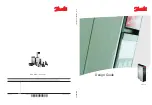
4. OPERATING INSTRUCTIONS
WARNING! Ensure you read, understand and apply
safety instructions before use.
4.1.
Only use impact sockets which are specifically designed
for use with a impact wrench.
4.2.
Connect the wrench to the air hose as in chapter 3.
4.3.
Place the socket over the subject nut and depress the
trigger to operate the wrench.
4.4.
To change direction turn the air regulator on the rear of
the body to the desired direction (fig.3).
4.5.
The air flow may be regulated by adjusting the air
regulator on the rear of the body.
DO NOT
use any additional force upon the wrench in
order to remove a nut.
DO NOT
allow wrench to free run for an extended period
of time as this will reduce bearing life.
WARNING!
Ensure the air supply is clean and does not exceed 90psi while operating the
wrench. Too high an air pressure and/or unclean air will shorten the product life due to
excessive wear, and may be dangerous causing damage and/or personal injury.
3.1. AIR
SUPPLY
3.1.1. Ensure wrench air valve (or trigger) is in the "off" position before connecting to the air
supply.
3.1.2. You will require an air pressure of 90psi, and an air flow according to specification.
3.1.3. Drain the compressor air tank daily. Water in the air line will damage the wrench.
3.1.4. Clean compressor air inlet filter weekly. Recommended hook-up procedure is shown in fig.1.
3.1.5. Line pressure should be increased to compensate for unusually long air hoses (over 8
metres). The minimum hose diameter should be 1/4” I.D. and fittings must have the same
inside dimensions.
3.1.6. Keep hose away from heat, oil and sharp edges. Check hose for wear, and make certain
that all connections are secure.
3.2. COUPLINGS
Vibration may cause failure if a quick change coupling is connected directly to the wrench.
To overcome this, connect a leader hose to the wrench. A quick change coupling may then
be used to connect the leader hose to the air line recoil hose. See fig.1 & 2.
3. PREPARING WRENCH FOR USE
fig.3
fig.1
fig.2
Original Language Version
GSA6004 Issue:4(SP)-18/06/13
© Jack Sealey Limited






















